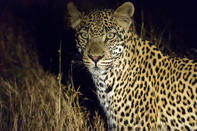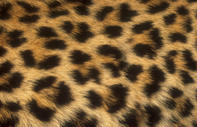Excellent Vision and Hearing
A leopard’s vision is excellent and used to locate prey. Forward facing eyes provide the binocular vision necessary for gauging depth and distance.

A high occurrence of rod cells (for black and white detection) in the retina of the eye makes it easier to see at night under conditions of light and shadow. Leopards also have a tapetum lucidum behind the retina of their eyes.
This is a reflective layer that reflects light back onto the retina a second time to increase the stimulation of the retinal light-sensitive cells to improve vision in low light conditions. Leopards rely on their good sense of hearing when communicating over long distances. They vocalize with a rasping call that sounds like wood under a saw.
Due to a suspensorium (non-ossified voice box that vibrates) like that of a lion, leopards can send long-range messages to denote territory, make contact with offspring or locate mates. A female’s call can be distinguished from a male’s by being longer in duration and with a higher frequency of rasps.
Tactile Senses Used Too

Leopards have long whiskers (also known as vibrissae).
These are tactile sensory organs that indicate to the leopard whether it will fit through a particular sized gap.
This is an important adaptation to moving around in the darkness. Leopards have a large cultural significance and capes made from leopard skins are worn as ceremonial costumes to denote the status of the wearer.
Sometimes stock thieving leopards are pursued and killed by young men seeking to prove their manhood to their community. Traditional medicine incorporates the use of leopard’s whiskers.
By Megan Emmett